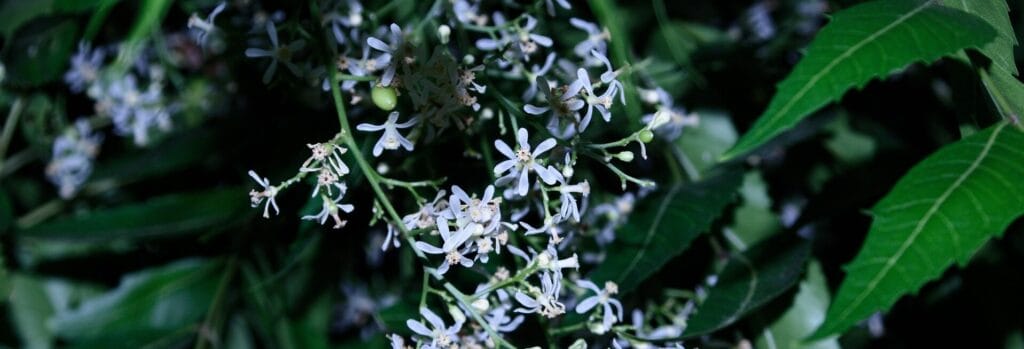For thousands of years, parts of the Neem tree have been used for its medicinal and insecticidal properties.
Considered sacred by the Indians, the legendary Neem tree is a symbol of good health and protection, which is why the Indians call it the "village pharmacy".
The ancient Ayurvedic tradition is said to consist primarily of preparations that include the use of neem in one form or another.
Used in medicine, the healing properties of neem oil improve health and boost immunity.
Traditionally, neem oil has been used to create skin and hair care products that soothe dryness, repair damage, remove bacteria, remove head and body lice, prevent baldness, and slow down graying of hair.
HARVEST from May to June | |
| PART OF THE PLANT The nuts | |
| METHOD OF EXTRACTION Cold pressing |
It was believed that when the wind passed through the neem trees and entered the surrounding houses, it carried the antibacterial properties of the tree, protecting the houses from bacteria and providing residents with a cool breeze during the summer months. Livestock and cattle were fed neem leaves to alleviate disease, and the soil was fertilized with seeds, leaves and bark that served as pesticides.
Traditionally, Neem tree derivatives have been used topically to treat ailments such as fever, respiratory problems, tetanus, rheumatism, arthritis, jaundice, malaria, fungus, lice, fungal and bacterial skin infections, scabies, hives, eczema, psoriasis and gastrointestinal intestinal diseases. In the past, neem oil was even used as a topical contraceptive.
Of all the commercially available neem products, neem oil is considered to be the most important for organic farming and medicine. Traditionally, the oil and other parts of the tree were used for its natural insect repellent properties, as well as to remove lice and dandruff. It could also prevent baldness, delay graying of hair, soothe the skin, remove bacteria. Many of these uses are still relevant today, making neem oil one of the most popular choices for use in soaps, cosmetics and massage oils.

How is Neem oil extracted?
Neem oil is obtained from the fruit, seeds, nuts or seed pulp by cold pressing, high pressure steam extraction or solvent extraction.
The first step in any method is to remove the pulp from the seeds and then air-dry the seeds in a cool, low-humidity room. The seed husks are then removed before proceeding with the extraction method.
In the cold-pressed method, which is the oldest method, the fresh, light green beans are crushed and pressed to release the oils, which are then collected. The fresh seeds yield oils with a light color and a lighter and more tolerable aroma. The old or rancid grains yield a dark oil with a strong and disagreeable odor similar to that of sulphur. Of all the methods of extracting neem oil, cold pressing produces the best quality oil consisting of all active ingredients. The second pressing produces an oil of a quality best suited for the production of soaps and insect repellents.
In the high-pressure steam extraction method, the nuts are steamed to increase the flow of oils for the next step, which is subjecting them to high pressure to squeeze out the oils. In this method, the resulting oil is dark and gives off an unpleasant odor, and the valuable properties of the oil can potentially be destroyed by the application of heat.
In the solvent extraction method, the nuts are crushed finely and placed in a vessel where they are soaked in an organic solvent, usually hexane, which extracts the neem oil. After extraction of the solvent, the remaining oil is relatively clear. In this method, many of the pungent components of the oil that are not soluble in hexane remain, making the final product suitable for use in health and cosmetic products. Alternatively, the nuts can be pressed first, resulting in a seed pulp, from which the remaining oil can then be extracted using hexane.
There are different colors of neem oil which vary between golden yellow, yellowish brown, reddish brown, dark brown, greenish brown and bright red. It is known to have a strong odor that can be likened to a mixture of peanut and garlic flavors. The highest quality neem oil is obtained from the seeds of the fruit that are plucked from the tree, not from those that are collected after they have fallen to the ground.
Application and action
| Physical Application: Balances oil production, heals wounds, stimulates collagen formation, reduces acne scars and minimizes skin inflammation, purifies blood, helps clear skin from sun-induced dark spots | Physical action: Anti-inflammatory, antibacterial, antiseptic, antimicrobial, antioxidant, revitalizing |
Used topically, neem oil can soothe red, itchy, and inflamed skin associated with issues like acne, burns, rosacea, eczema, psoriasis, rashes, and more. Neem oil works as a natural replacement for anti-aging products and as a protective agent against skin damage caused by UV rays. It penetrates deep into the skin to restore moisture, improve elasticity, smooth wrinkles, stimulate collagen production and strengthen dry, cracked skin. Reduces redness and gives a healthy glow. Its ability to unclog pores and follicles while soothing irritated skin without leaving an oily residue makes neem oil an effective remedy for acne-prone skin. It prevents future breakouts by eliminating acne-causing bacteria, cleaning impurities, tightening pores, and evens skin tone. By softening the skin and making it supple, it facilitates the healing of scars and reduces their appearance and feel.
When used in the hair, neem oil naturally removes dandruff and balances the hair's natural pH level, preventing future dandruff. It not only detangles hair, but also prevents hair thinning caused by pollution, stress or medications, promoting the growth of stronger and tamer hair. Regular application of neem oil to the scalp moisturizes hair from root to tip, supports scalp health and repairs split ends that can stop hair growth and create breakage. Neem oil can rejuvenate and strengthen stressed, damaged hair by nourishing it to restore shine and strength.
Neem oil contains components that prevent and eliminate fungal infections. By soothing the irritation and eliminating the bacteria that cause it. It can soothe skin conditions such as ringworm, athlete's foot, toenail fungus and cold sores. By suffocating the parasites that live on the skin, it effectively eradicates diseases such as scabies and lice. When applied to minor wounds, neem oil reduces inflammation and promotes faster healing by increasing blood flow to the area and helping to create collagen fibers that strengthen, tighten and shape the skin.
RECIPES WITH NEM OIL

The uses of neem oil are numerous and range from medicinal to cosmetic. Its many forms include oils, gels, lotions, creams, soaps and shampoos.
Used topically, neem oil can soothe skin conditions such as inflammation and reduce feverish body temperature, while relieving joint and muscle pain caused by rheumatic diseases. Neem oil can be applied to the skin as a toner that restores moisture to the face while eliminating pathogens below the skin's surface to make skin look and feel healthier and younger. To nourish dry skin, neem oil can be mixed with coconut oil before applying. Additionally, a few drops of lemon or lavender essential oil can be added to this mixture for a more pleasant aroma.
To combat acne, neem oil can be mixed with olive oil before applying to the face and left on for an hour. After this period, it can be washed off or left on the face overnight, depending on personal preference.
To lighten areas of skin that are affected by hyperpigmentation and to regulate melanin production, a few drops of neem oil can be applied to these areas with a cotton swab.
To remove lice 2 tbsp neem oil they can be heated and applied to the hair, which can then be wrapped in a scarf or towel to allow the oil to soak into the scalp overnight. The next morning, dead lice may appear on the scarf or towel. The oil can be washed out of the hair with an herbal shampoo.
| CREAM FOR IRRITATED SKIN 40 gr organic shea butter 30 gr. cocoa butter 20 gr castor oil 30 gr almond butter 10 gr Neem oil 30 drops lavender essential oil |
Mix the oils and massage the desired area to relieve irritated skin, after insect bites, acne, eczema, sunburn or minor injuries.
| AGAINST INSECTS The dispersion of neem oil in the house it will keep mosquitoes and other bugs away. Save on expensive pesticides and simply keep neem oil-soaked cotton swabs in mosquito-infested areas. |
Place all ingredients in a container or bottle. Mix them by shaking well. Apply to your skin as a moisturizer 2-3 times a day.
Make sure you always dilute pure neem oil before using it directly on the skin. Before applying the moisturizer to your face, do a spot test. In case of skin reaction or irritation, wash your face and discontinue use.
MORE INTERESTING ARTICLES FROM THE BLOG
- VITAMIN WITH SERUM - WHY ADD IT TO YOUR DAILY BEAUTY ROUTINE?
- EVENING MINERAL OIL - BENEFITS AND APPLICATIONS
- YANG YANG ESSENTIAL OIL - BENEFITS AND APPLICATIONS
- ESSENTIAL OIL OF WHITE RAVNETS - BENEFITS AND APPLICATIONS
- MASSAGE OIL FOR HANDS "SUN FOR THE SOUL"
CATEGORIES
- AROMATHERAPY
- ESSENTIAL OILS
- BASE OILS
- DIFFUSION METHODS
- NATURAL COSMETICS
- RECIPES WITH ESSENTIAL OILS

The information in this article is for educational purposes only and is not intended to serve as a basis for prevention or treatment.
- https://en.wikipedia.org/wiki/Neem_oil
- https://www.healthline.com/health/grapeseed-oil-for-skin
- Valerie Ann Worwood, The Complete Book of Essential Oils and Aromatherapy
Photos: Primavera Life